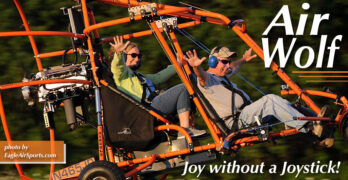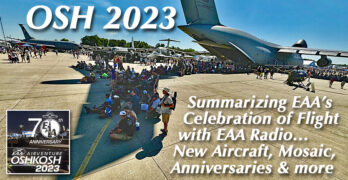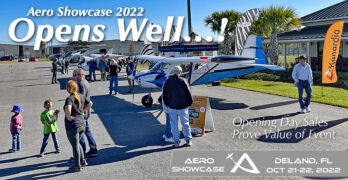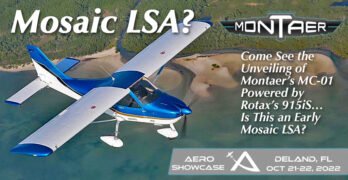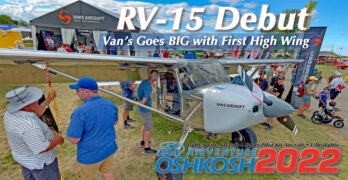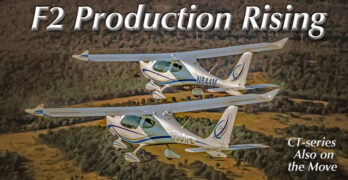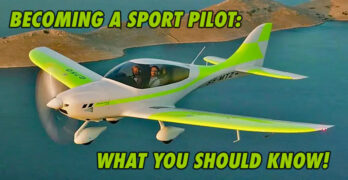Last summer, when EAA AirVenture Oshkosh exploded with news that FAA released Mosaic, nearly all the attention was on increased weight and speed, and capabilities like retractable gear, controllable props, even multiengine or turbine aircraft. Christmas in July, I called it, so plentiful were FAA’s gifts to pilots and industry.
While all these items will add capability, they also increase prices. Is that what you want? Let me guess not for most readers. This website thrives on affordable aviation. Features that add substantial cost limit affordability.
Mosaic will trigger a bifurcation within the LSA community and it goes something like this: If you like the airplane you have now, you probably will not like the price of a Mosaic LSA. However, if you feel constrained in weight-carrying capacity or speed or if you want multiple engines, then Mosaic may address your wishes.
The great news? You can have it both ways.
Search Results for : Mosaic LSA
Not finding exactly what you expected? Try our advanced search option.
Select a manufacturer to go straight to all our content about that manufacturer.
Select an aircraft model to go straight to all our content about that model.
AirVenture Oshkosh 2023 Is Done; Here’s an Overview Done On-Air with EAA Radio
It’s all over — EAA AirVenture Oshkosh, the world’s largest-attendance airshow event. It’s a delicious, if somewhat overwhelming, drink out of a firehose for an entire week.
Oshkosh has something for every pilot and more than any one person can see.
I’ll mention this news briefly as I wish to pay respect to fellow pilots. Two crashes on the weekend after we departed resulted in four fatalities reportedly including one passenger. My sincere condolences to the surviving families. Oshkosh has had safe years with no loss of life but when so many airplanes assemble, mathematical odds suggest a crash is going happen despite heroic efforts to make the event as safe as possible.
During the week of Oshkosh, a few days were rather warm. Cooling rains came mostly at night, sparing the airshow but surely soaking campers in tents. The campgrounds were full to the edges and EAA opened multiple other locations to handle the overflow.
EAA AirVenture Oshkosh 2023 — Set-up Day Tour to Whet Your Aviation Appetite
Do you know when you’re an airshow junkie, ‘er… enthusiast? Answer: When you actually enjoy observing the set-up process. I’ve made the following observation many times.
The night before opening, with literally hours before the show starts, the place appears in a state of chaos. Pandemonium reigns. Vehicles, crates, equipment of every kind is seemingly strewn about as if by a storm (which did do some damage on Saturday night, ironically most affecting those who started earlier).
Every show I think, “No way can they get this or that exhibit ready in the 10-15 hours before the main gates open to hundreds of thousands of visitors.”
Yet every show on opening day, I find myself saying, “What?! It’s all done!” Did they work all night? Even if staff was willing to work all night, it seemed unlikely to get the job done mere hours earlier. Maybe it’s magic or Santa’s Elves.
Big, Beautiful, Powerful — The Highly Finished Montaer MC01 with Rotax 915iS
Pilots love airplanes (duh!). Pilots also love engines, especially when they are truly powerful. So, perhaps Brazilian manufacturer Montaer made a market-savvy move by moving quickly to incorporate Rotax’s most potent engine, their 915iS producing 141 horsepower in a turbocharged and intercooled package. The result of Bruno de Oliveira‘s design work is MC01 915 as seen in the nearby photos and in more detail in the video below.
Other powerful engines are available, for example, the even-higher-horsepower Titan from Continental Aerospace. These powerplant designs are sharply different because the Rotax uses a smaller displacement and is physically more compact. The 9-series is also significantly less noisy and it boasts the latest technology from an engine builder cranking out thousands of engines a year (when counting the many non-aircraft engines the Austrian company makes).
I wrote that Bruno moved quickly. That’s because this is a new model, first introduced to Americans only last year.
Aero Showcase — Day One: Inaugural Event Starts Well with Sales Logged
I have long recognized that one of the toughest things a group can do is decide to launch and operate a new event. I think this is probably true outside of aviation as well but it’s certainly tough to do with airshows where weather is one of many factors you need to consider.
With that in mind I would say that Day One of Aero Showcase 2022 — the rebadged and revised version of the five-year-old DeLand Sport Aviation Showcase — should be judged a success.
Coming Together
As I arrived on Friday morning, a weekday and therefore a workday for many, I was pleasantly surprised to see nearly every airplane present had a small cluster of people around it. Organizers benefited from a beautiful day in the mid-70s and the outlook for Saturday is equally good. Weather is forecast in the upper-70s with mostly sunny skies and almost no chance of rain.
First-Ever Montaer MC01 915iS to Debut at Season-Finale Aero Showcase This Weekend
When I asked “Mosaic LSA?” in the lead image of this article, was I simply being provocative? Or, is the soon-to-be-debuted Montaer MC01 with Rotax 915iS a forecast of what is to come with Mosaic?
Hopefully the title did get your attention but it asks a legitimate question for buyers of new potentially-Mosaic-compliant Light-Sport Aircraft.
The reason I feel this way is not merely the 141-horsepower engine Montaer designer Bruno Oliveira installed on the nose of his three-door LSA (see earlier review, before 915).
A more significant reason is that this airplane is one of several that may be able to re-declare compliance and get a substantial weight increase. It will already have a powerful-enough engine to lift a heavier load.
So, buyers of this airplane (and I repeat, MC01 will not be the only such choice) may be able to acquire a present-day 1,320-pound LSA and later get it bumped to perhaps 1,600-1,700 pounds, maybe more.
RV-15 High Wing Debuts to Crowds at Oshkosh 2022; Does Van’s Know Something You Don’t?
Is it an LSA or is it not an LSA? Is that the question?
When Van’s broke the news that their latest RV-15 model was a high wing, plenty of pilots snapped to attention. This company has produced one winner after another; here is their latest. Its bare aluminum glistened in bright sunlight and drew crowds through every day of Oshkosh 2022.
Will the model join the long line of distinguished RV models as a kit-built aircraft or could the company’s first-ever high wing signify something else. After all, Van’s did bring in-house full manufacturing of their successful RV-12 LSA.
Does Van’s know something you don’t know? Oh, very probably they know far more than you know but the question digs at who knows what FAA is doing. Here’s one company that may have a better handle on that than most others.
Van’s president Rian Johnson is the head of the ASTM F37 committee that is working closely with the FAA to formulate standards that will be used when the new breed of LSA come on the market, which I now predict will happen in 2025.
BRP-Powertrain (Rotax Aircraft Engines)
Flight Design Increases F2 Production — Moves CT-Series
As we Floridians prepare to face Hurricane Milton starting later today, I’m pleased to give an update on one of our leading companies in the LSA space. I refer to Flight Design, which gained fame for the enviable success of its CT-series aircraft (CT2K, CTSW, CTLS, CTLSi, CT Super). In the United States, more of these models fly as LSA than aircraft from any other brand.
In the USA, importing Flight Design aircraft is now handled by Airtime Aviation, a leader in its own right. For two decades, Airtime has been the nation’s #1 seller of Light-Sport Aircraft, delivering to American pilots a large percentage of those hundreds of CT-series aircraft. Importing was previously handled by Flight Design USA; regional dealers also contributed to enlarging the CT fleet in this country. The German designer has enjoyed good success in numerous countries.
In addition to those many sales, Flight Design has long been a leader among western producers moving into Eastern Europe to take advantage of skilled technical workers and engineers.
Sport Pilot Certificate – What You Need to Know
The Sport Pilot Certificate has emerged as a popular option for aspiring pilots who want to experience the joy of recreational flying without the extensive time and financial commitment required for a Private Pilot Certificate. It’s been with us for two decades but there are still questions about the SP certificate. Here’s a rundown.
There are seven main categories of aircraft for which you can be a Sport Pilot, each with variations on training and pilot requirements specific to that Category. This article will be specific to the Airplane Category.
What is the Sport Pilot Certificate?
The Sport Pilot Certificate allows pilots to fly a Light Sport Aircraft (LSA). These aircraft are typically smaller, simpler and more affordable to operate. Key characteristics of LSAs include:
Maximum takeoff weight of 1320 pounds (or 1430 for seaplanes)
Maximum airspeed in level flight of 120 knots under standard atmospheric conditions
Maximum stall speed of 45 knots in landing configuration
Single, non-turbine engine
Fixed pitch or ground adjustable propeller
Fixed landing gear (except for seaplanes)
Note that all of these are under the current LSA/SP rules and are likely to change when MOSAIC becomes reality next year.
- « Previous Page
- 1
- …
- 6
- 7
- 8
- 9
- 10
- …
- 14
- Next Page »


